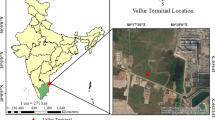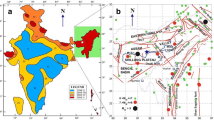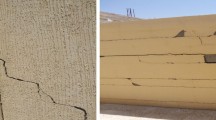Abstract
The main objective of the present study is to investigate and evaluate the geo-environmental characteristics of continental Sabkha soil. This type of soil is widespread throughout the world, especially in Saudi Arabia. For the current work, disturbed and undisturbed samples are extracted from a site in Tymaa, Saudi Arabia. The natural geotechnical properties are determined, and chemical analyses are performed. Modified compaction, California bearing ratio (CBR), direct shear, and potential collapse tests are conducted experimentally on the soil, with the obtained results indicating that Sabkha soil is poorly graded sand and contains high concentrations of salts, causing a corrosive environment. Therefore, reinforced concrete foundations of structures built on this type of soil should be protected. In the tests, the compacted samples induce high values of shear strength and CBR. However, the soaked Sabkha soils show very low values of shear strength parameters and CBR compared to those of non-soaked samples. Hence, Sabkha soil indicates collapsible behaviour when soaked in water, which is attributable to the weak salt bonds between the soil grains. Also carried out in this work are numerical simulations of a fuel tank resting on unsaturated and saturated Sabkha soil, utilizing 2D and 3D Plaxis programs. The numerical analyses results show that while unsaturated soil has good performance under tank loads, it collapses under the loads when soaked in water. These outcomes match experimental results. In the limit state, the raft foundation on saturated soil shows greater values of settlement and internal forces compared to those of the raft foundation prior to immersion. Hence, Sabkha soil requires treatment before being built on.















Similar content being viewed by others
References
Renfro AR (1974) Genesis of evaporite-associated stratiform metalliferous deposits—a Sabkha process. Econ Geol 69(1):33–45
El-Naggar ZR (1988) Foundation problems in Sabkha deposits. Short course on foundation engineering for the practicingengineer. King Fahd University of Petroleum and Minerals, Dhahran, pp 1–54
Kinsman DJJ (1969) Modes of formation, sedimentary associations, and diagnostic features of shallow-water and supratidal evaporites. Am Assoc Pet Geol Bull (AAPG) 53(4):830–840
Szabolcs I (1979) Review of research on salt-affected soils. In: Natural resources research XV. UNESCO, Paris
Bohn HL, McNeal BL, O’Connor GA (1985) Salt-affected soils in soil chemistry, 2nd edn. Wiley, New York, pp 234–261
Ellis GI (1973) Arabian salt-bearing soil (Sabkha) as an engineering material. TRRL Report LR, Crowthorne, Berkshire, pp 523
Fookes PG, Collis L (1975) Problems in the middle east. Concrete 9(7):12–17
Al-Amoudi OSB (1992) Studies on soil-foundation interaction in the Sabkha environment of the eastern province of Saudi Arabia. Ph.D. dissertation, Department of Civil Engineering, King Fahd University of Petroleum and Minerals, Dhahran: I and II
Al-Amoudi OSB, El-Nagshgar ZR, Asi IM (1992) The Sabkha soil in the kingdom of Saudi Arabia and its engineering problems. Al-Muhandis (Engineer) 6(2):56–62 ((in Arabic))
Johnson H, Kamal MR, Pierson GO, Ramsay JB (1978) Sabkhahs of eastern Saudi Arabia. In: Al-Sayari SS, Zotl JG (eds) Quaternary period in Saudi Arabia, vol 1. Springer, Berlin, pp 84–93
Al-Shamrani MA, Dhowian AW (1997) Preloading for reduction of compressibility characteristics of Sabkha soil profiles. Eng Geol 48:19–41
Al-Amoudi OSB (2002) Characterization and chemical stabilization of Al-Qurayyah Sabkha soil. J Mater Civ Eng 14(6):478–484
Al-Amoudi OSB, Abduljauwad SN, El-Naggar ZR, Rasheeduzzafar A (1992) Response of Sabkha to laboratory tests: a case study. Eng Geol 33(2):111–125
Khan IH, Hasnain SI (1981) Engineering properties of Sabkha soils in the Benghazi plain and construction problems. Eng Geol 17(3):175–183
Ismael NF (1993) Laboratory and field leaching tests on coastal salt-bearing soils. J Geotech Eng 119:453–470
Ali KM, Malik I, Ibrahim AM (2015) Geotechnical properties of Sabkha soil in the southern part of Al-Khobar city, KSA. J Eng Res Appl 5(6):24–29
Messad A, Moussai B (2015) Effect of water salinity on Atterberg limits of El-Hodna Sabkha soil. Bull Eng Geol Environ 75(1):301–309
Nasr AM (2015) Geotechnical characteristics of stabilized Sabkha soils from the Egyptian–Libyan coast. Geotech Geol Eng 33:893–911
Aqeel A (2016) Investigation of expansive soils in Obhor Sabkha. Jeddah-Saudi Arabia Arab J Geosci 9(4):314
Jung C, Ceglarek R, Clauvelin T (2020) Deep soil mixing in Sabkha soils for foundation support in United Arab Emirates. Int J Geosynth Ground Eng 6:3. https://doi.org/10.1007/s40891-020-0188-4
Asi IM (2001) Stabilization of Sabkha soil using foamed asphalt. J Mater Civ Eng ASCE 13(5):325–331
Sabtan AA (2005) Performance of a steel structure on Ar-Rayyas Sabkha soils. Geotech Geol Eng 23:157–174
Mohamedzein YE, Al-Rawas AA (2011) Cement-Stabilization of Sabkha Soils from Al-Auzayba, Sultanate of Oman. Geotech Geol Eng 29:999
Alnuaim A, El Naggar MH (2014) Performance of foundations in Sabkha soil: numerical investigation. Geotech Geol Eng 32:637–656
Al-Homidy AA, Dahim MH, Abd El Aal AK (2017) Improvement of geotechnical properties of Sabkha soil utilizing cement kiln dust. J Rock Mech Geotech Eng 9:749–760
He J, Chu J (2017) Cementation of sand due to salt precipitation in drying process. Mar Georesour Geotechnol 35(3):441–445
Matchala S, Park JS, Kim BY, Choi TG, Jun YC (2019) Geotechnical behaviour and construction problems of Sabkha soil. In: Randolph M, Doan D, Tang A, Bui M, Dinh N (eds) Proceedings of the 1st Vietnam symposium on advances in offshore engineering. Springer, Singapore
Al-Amoudi OSB (2008) Testing and stabilization of saline Sabkha soils: a review. In: On case histories in geaotechnical engineering. Arlington, Virginia
Messad A, Debbab OY, Moussai B (2017) Effect of water salinity on the compaction of Sabkha soils. In: 2nd International conference "challenges in geotechnical engineering, Ukraine
Stipho A (1985) On the engineering properties of salina soil. Q J Eng Geol Hydrogeol 18:129–137
Akili W, Torrance J (1981) The development and geotechnical problems of Sabkha, with preliminary experiments on the static penetration resistance of cemented sands. Q J Eng Geol Hydrogeol 14:59–73
Al-Amoudi OSB, Abduljauwad SN (1995) Strength characteristics of Sabkha soils. Geotech Eng J 26(1):73–92
Benmebarek S, Berrabah F, Benmebarek N (2015) Effect of geosynthetic on the performance of road embankment over Sabkha soils in Algeria: case study. Int J Geosynth Ground Eng 1:35
Al-Taie AJ, Albusoda BS, Alabdullah SFI (2019) An experimental study on leaching in gypseous soil subjected to triaxial loading. Geotech Geol Eng 37:5199–5210. https://doi.org/10.1007/s10706-019-00974-2
Al-Amoudi OSB, Aiban SA, Abdul Wahab HI (1997) Variability and characteristics of eastern Saudi Sabkha solids. In: Proceedings of the 14th internnational conference on soil mechanics, Hamburg. pp 17–20
Abduljauwad SN (1997) Unsaturated soil problems in the Kingdom of Saudi Arabia. In: Proceedings of the symposium on civil engineering and the environment. KFUPM, Dhahran, pp 125–138
Sakr M, Mashhour M, Hanna A (2008) Egyptian collapsible soils and their improvement. In: GeoCongress. pp 654–661
Binda L, Saisi A, Tiraboschi C (2000) Investigation procedures for the diagnosis of historic masonries. Construct Build Mater 14:199–233
Ingham J, Griffith M (2010) Performance of unreinforced masonry buildings during the 2010 Darfield (Christchurch, NZ) earthquake. Aust J Struct Eng 11:207–224
Morcillo M (1999) Soluble salts: their effect on premature degradation of anticorrosive paints. Prog Org Coat 36:137–147
Al-Sanad H, Ismael N, Nayfeh A (1993) Geotechnical properties of dune sands in Kuwait. Eng Geol 34:45–52
Vincent P (2003) Jeddah’s environmental problems. Geograph Rev 93:394–412
Ann KY, Song H-W (2007) Chloride threshold level for corrosion of steel in concrete. Corros Sci 49:4113–4133
Kumar S, Kameswara Rao CVS (1994) Effect of sulfates on the setting time of cement and strength of concrete. Cem Concr Res 24:1237–1244
Abdullah GM (2020) Pavement thickness design charts derived from rut depth models developed for foamed and emulsified sulfur asphalt soil mixes. Geotech Geol Eng 38:1–13
Abu-Taleb MG, Egeli I (1981) Some geotechnical problems in the eastern province of Saudi Arabia. In: Proceedings of symposium on geotechnical problems in Saudi Arabia. King Saud University, Riyadh, pp 799–811
Elsawy MB, Lakhouit A (2020) A review on the impact of salinity on foundation soil of coastal infrastructures and its implications to north of Red Sea coastal constructions. Arab J Geosci 13(13):1–12
Al-Dalamah A, Al-Hurban A (2019) The impact of urbanization expansion on the geomorphology of the southern coastal Sabkhas FROM Ras Al-Jailiaha to Al-Khiran, South Kuwait. J Geograph Inf Syst 11(05):609
Abduljauwad SN, Al-Amoudi OSB (1995) Geotechnical behaviour of saline Sabkha soils. Geotechnique 45(3): 425–445
Amin A, Bankher K (1997) Causes of land subsidence in the Kingdom of Saudi Arabia. Nat Hazards 16(1):57–63
Elsawy M (2020) Performance of water tank resting on reinforced weak soil with RC piles, conventional and geogrid-encased stone piles. In: International conference of civil and environmental engineering "innovation and boosting sustainable development", ICCEE-2020. Hurghada, Egypt
Alawaji HA (1998) Model plate-load tests on collapsible soil. J King Saud Univ Eng Sci 10(2):255–270
Ng KS, Tan SA (2014) Stress transfer mechanism in 2D and 3D unit cell models for stone column improved ground. Int J Geosynth Ground Eng 1:3
Vesic AS (1973) Analysis of ultimate loads of shallow foundations. J Soil Mech Found Div ASCE 99(1):45–73
Funding
The present research was not supported by any fund.
Author information
Authors and Affiliations
Corresponding author
Ethics declarations
Conflicts of interest
Authors of the present article declare that they have no conflict of interest.
Additional information
Publisher's Note
Springer Nature remains neutral with regard to jurisdictional claims in published maps and institutional affiliations.
Rights and permissions
About this article
Cite this article
Elsawy, M.B.D., Lakhouit, A. Geotechnical Behaviour of Sandy Sabkha Soils Based on Experimental and Numerical Investigations. Indian Geotech J 52, 97–112 (2022). https://doi.org/10.1007/s40098-021-00555-2
Received:
Accepted:
Published:
Issue Date:
DOI: https://doi.org/10.1007/s40098-021-00555-2




